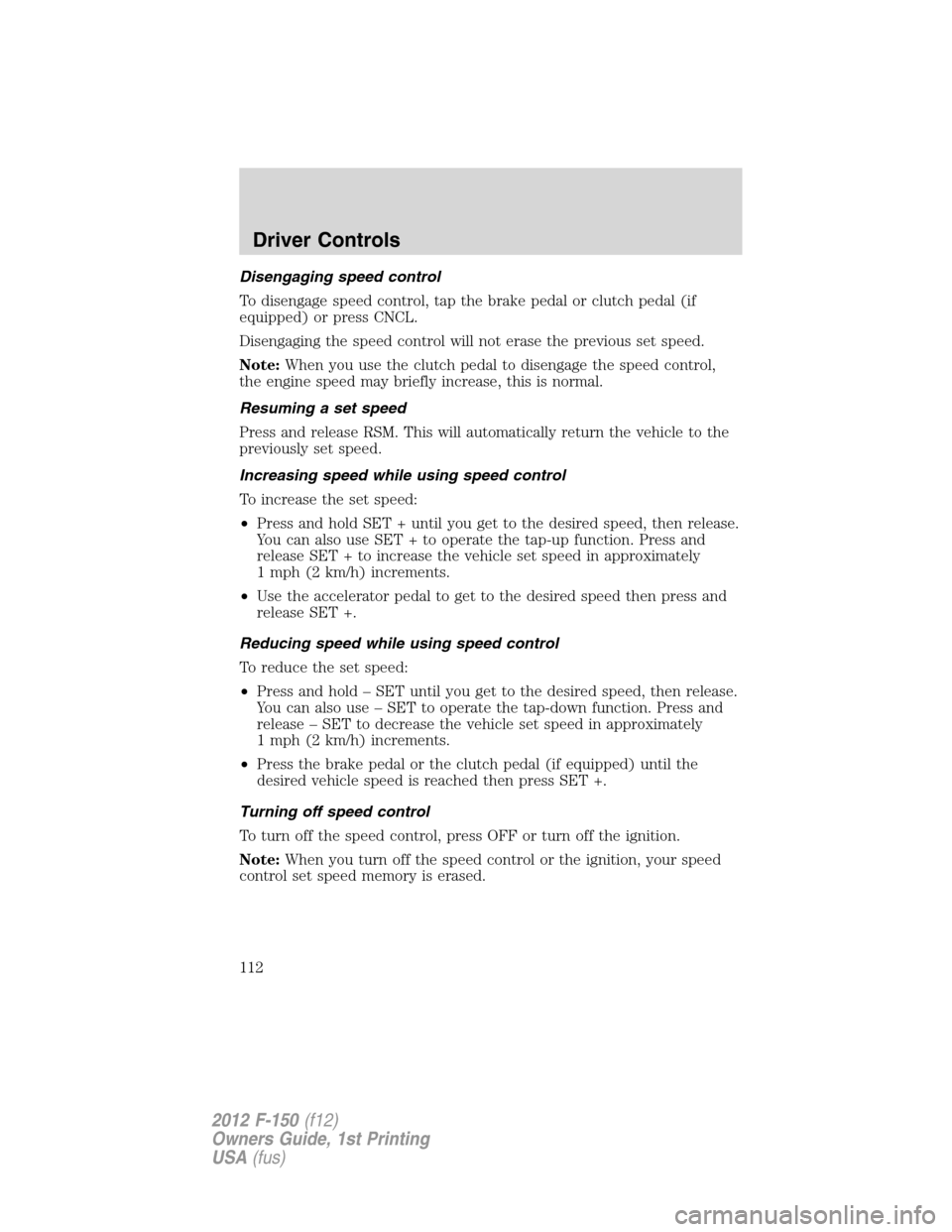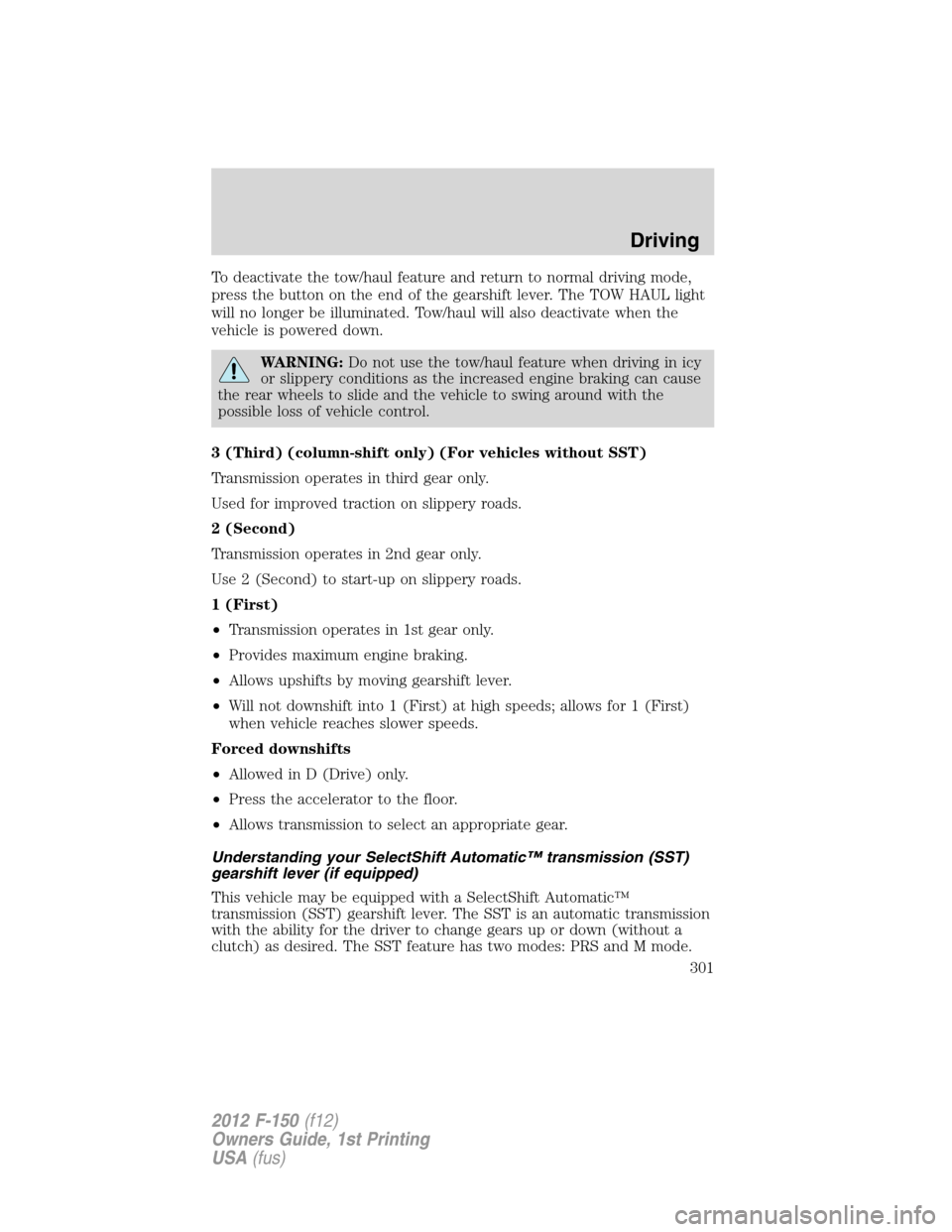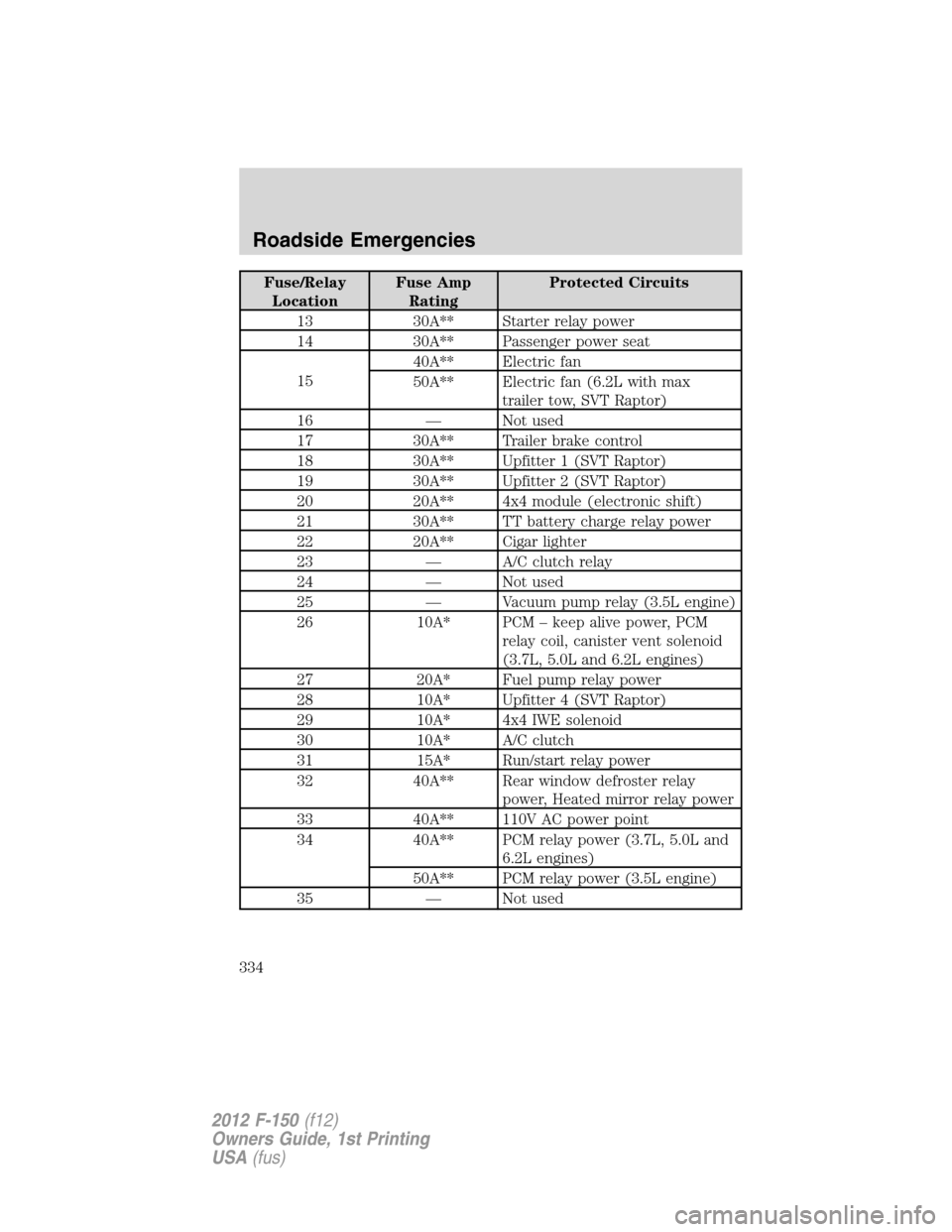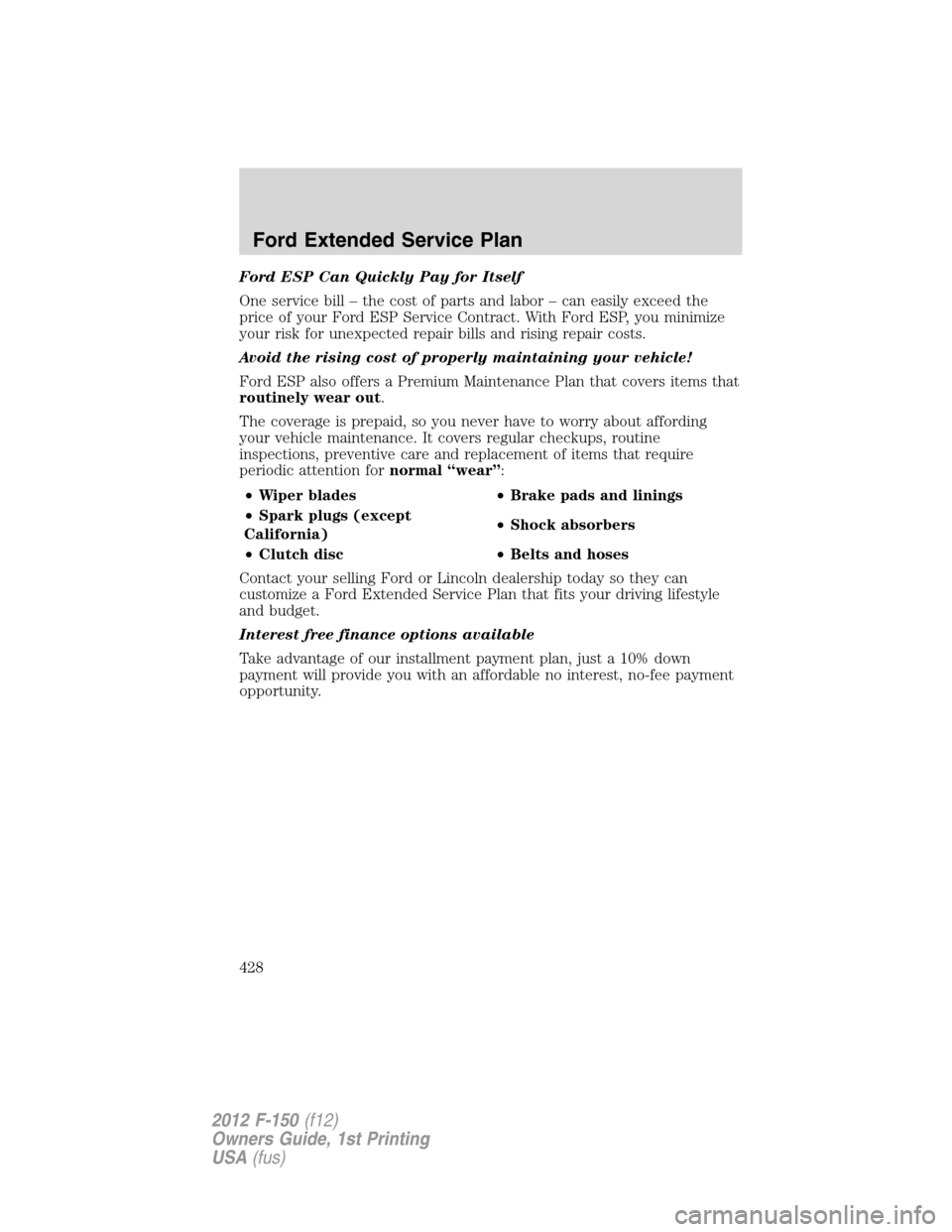2012 FORD F150 clutch
[x] Cancel search: clutchPage 112 of 462

Disengaging speed control
To disengage speed control, tap the brake pedal or clutch pedal (if
equipped) or press CNCL.
Disengaging the speed control will not erase the previous set speed.
Note:When you use the clutch pedal to disengage the speed control,
the engine speed may briefly increase, this is normal.
Resuming a set speed
Press and release RSM. This will automatically return the vehicle to the
previously set speed.
Increasing speed while using speed control
To increase the set speed:
•Press and hold SET + until you get to the desired speed, then release.
You can also use SET + to operate the tap-up function. Press and
release SET + to increase the vehicle set speed in approximately
1 mph (2 km/h) increments.
•Use the accelerator pedal to get to the desired speed then press and
release SET +.
Reducing speed while using speed control
To reduce the set speed:
•Press and hold – SET until you get to the desired speed, then release.
You can also use – SET to operate the tap-down function. Press and
release – SET to decrease the vehicle set speed in approximately
1 mph (2 km/h) increments.
•Press the brake pedal or the clutch pedal (if equipped) until the
desired vehicle speed is reached then press SET +.
Turning off speed control
To turn off the speed control, press OFF or turn off the ignition.
Note:When you turn off the speed control or the ignition, your speed
control set speed memory is erased.
Driver Controls
112
2012 F-150(f12)
Owners Guide, 1st Printing
USA(fus)
Page 301 of 462

To deactivate the tow/haul feature and return to normal driving mode,
press the button on the end of the gearshift lever. The TOW HAUL light
will no longer be illuminated. Tow/haul will also deactivate when the
vehicle is powered down.
WARNING:Do not use the tow/haul feature when driving in icy
or slippery conditions as the increased engine braking can cause
the rear wheels to slide and the vehicle to swing around with the
possible loss of vehicle control.
3 (Third) (column-shift only) (For vehicles without SST)
Transmission operates in third gear only.
Used for improved traction on slippery roads.
2 (Second)
Transmission operates in 2nd gear only.
Use 2 (Second) to start-up on slippery roads.
1 (First)
•Transmission operates in 1st gear only.
•Provides maximum engine braking.
•Allows upshifts by moving gearshift lever.
•Will not downshift into 1 (First) at high speeds; allows for 1 (First)
when vehicle reaches slower speeds.
Forced downshifts
•Allowed in D (Drive) only.
•Press the accelerator to the floor.
•Allows transmission to select an appropriate gear.
Understanding your SelectShift Automatic™ transmission (SST)
gearshift lever (if equipped)
This vehicle may be equipped with a SelectShift Automatic™
transmission (SST) gearshift lever. The SST is an automatic transmission
with the ability for the driver to change gears up or down (without a
clutch) as desired. The SST feature has two modes: PRS and M mode.
Driving
301
2012 F-150(f12)
Owners Guide, 1st Printing
USA(fus)
Page 314 of 462

Note:Momentarily releasing the accelerator pedal while performing a
shift will improve engagement/disengagement times.
Note:Do not perform this operation if the rear wheels are slipping.
Note:Some noise may be heard as the system shifts or engages; this is
normal.
Note:4X4 high mode is not intended for use on dry pavement.
Shifting to/from 4L (4X4 low)
1. Bring the vehicle to a speed of 3 mph (5 km/h) or less.
2. Place the transmission in N (Neutral).
3. Move the 4WD control to the desired position.
The message center will display4X4 SHIFT IN PROGRESSduring the
shift. The message center will then display the system mode selected. If
any of the above shift conditions are not met, the shift will not occur and
the message center will display information guiding the driver through
the proper shifting procedures.
IfSHIFT DELAYED PULL FORWARDis displayed in the message
center, transfer case gear tooth blockage is present. To alleviate this
condition, place the transmission in a forward gear, move the vehicle
forward approximately 5 feet (1.5 m), and shift the transmission back to
neutral to allow the transfer case to complete the range shift.
Note:Some noise may be heard as the system shifts or engages; this is
normal.
Note:4x4 low mode is not intended for use on dry pavement.
Using the ControlTrac 4WD system (if equipped)
This system includes an
electronically controlled transfer
case with a high capacity clutch.
The system is interactive with the
road, continually monitoring and
adjusting torque delivery to the
front and rear wheels to optimize
traction.
•2H (4X2)- delivers power to the
rear wheels only. This mode is
appropriate for normal on-road
driving on dry pavement and provides best fuel economy and
smoothness.
Driving
314
2012 F-150(f12)
Owners Guide, 1st Printing
USA(fus)
Page 315 of 462

•4A (Two-speed automatic 4WD)- provides electronic control
four-wheel drive with power delivered to the front and rear wheels, as
required, for increased traction. This is appropriate for all on-road
driving conditions, including as dry road surfaces, but is especially
useful on wet pavement, snow, dirt, or gravel.
•4H (4X4 HIGH)- provides electronically locked four-wheel drive
power to front and rear wheels. This position is not recommended for
use on dry pavement. This position is only intended for severe winter
or off-road conditions, such as deep snow, ice or shallow sand.Note:
Do not use 4H (4X4 HIGH) on dry, hard surfaced roads. Doing so can
produce excessive noise and increased tire wear. 4H (4X4 HIGH) is
only intended for consistently slippery or loose surfaces. Use of 4H
(4X4 HIGH) on these surfaces may produce some noise (such as
occasional clunks), but will not damage drive components.
•
4L (4X4 LOW)- provides electronically locked four-wheel drive when
extra power at reduced speeds is required. This position is not
recommended for use on dry pavement. Use this position for off-road
low-speed operation or when extra power is required, such as climbing
steep grades, going through deep sand or pulling a boat out of the water.
4L (4X4 LOW) will not engage while the vehicle is moving above 3 mph
(5 km/h); this is normal and should be no reason for concern. Refer to
Shifting to/from 4L (4X4 LOW)for proper operation.Note:Do not use
4L (4X4 LOW) on dry, hard surfaced roads. Doing so can produce
excessive noise and increased tire wear. 4L (4X4 LOW) is only intended
for consistently slippery or loose surfaces. Use of 4L (4X4 LOW) on
these surfaces may produce some noise (such as occasional clunks), but
will not damage drive components.
Note:The AdvanceTrac system has the ability to take over control of the
transfer case clutch and disable it during driving maneuvers when necessary.
Shifting between 2H (4X2) and 4A (Two-speed automatic 4WD) or
4H (4X4 HIGH )
Move the control from 2H to 4A or 4H at a stop or while driving at any
forward speed. The message center may display4X4 SHIFT IN
PROGRESSduring the system shift. The message center will then display
4X4 AUTOif 4A has been selected or4X4 HIGHif 4H is selected. The
message center will momentarily display4X2if 2H has been selected.
Note:Do not perform this operation if the rear wheels are slipping.
Note:Some noise may be heard as the system shifts or engages; this is
normal.
Note:4X4 high mode is not intended for use on dry pavement.
Driving
315
2012 F-150(f12)
Owners Guide, 1st Printing
USA(fus)
Page 334 of 462

Fuse/Relay
LocationFuse Amp
RatingProtected Circuits
13 30A** Starter relay power
14 30A** Passenger power seat
1540A** Electric fan
50A** Electric fan (6.2L with max
trailer tow, SVT Raptor)
16 — Not used
17 30A** Trailer brake control
18 30A** Upfitter 1 (SVT Raptor)
19 30A** Upfitter 2 (SVT Raptor)
20 20A** 4x4 module (electronic shift)
21 30A** TT battery charge relay power
22 20A** Cigar lighter
23 — A/C clutch relay
24 — Not used
25 — Vacuum pump relay (3.5L engine)
26 10A* PCM – keep alive power, PCM
relay coil, canister vent solenoid
(3.7L, 5.0L and 6.2L engines)
27 20A* Fuel pump relay power
28 10A* Upfitter 4 (SVT Raptor)
29 10A* 4x4 IWE solenoid
30 10A* A/C clutch
31 15A* Run/start relay power
32 40A** Rear window defroster relay
power, Heated mirror relay power
33 40A** 110V AC power point
34 40A** PCM relay power (3.7L, 5.0L and
6.2L engines)
50A** PCM relay power (3.5L engine)
35 — Not used
Roadside Emergencies
334
2012 F-150(f12)
Owners Guide, 1st Printing
USA(fus)
Page 428 of 462

Ford ESP Can Quickly Pay for Itself
One service bill – the cost of parts and labor – can easily exceed the
price of your Ford ESP Service Contract. With Ford ESP, you minimize
your risk for unexpected repair bills and rising repair costs.
Avoid the rising cost of properly maintaining your vehicle!
Ford ESP also offers a Premium Maintenance Plan that covers items that
routinely wear out.
The coverage is prepaid, so you never have to worry about affording
your vehicle maintenance. It covers regular checkups, routine
inspections, preventive care and replacement of items that require
periodic attention fornormal “wear”:
•Wiper blades•Brake pads and linings
•Spark plugs (except
California)•Shock absorbers
•Clutch disc•Belts and hoses
Contact your selling Ford or Lincoln dealership today so they can
customize a Ford Extended Service Plan that fits your driving lifestyle
and budget.
Interest free finance options available
Take advantage of our installment payment plan, just a 10% down
payment will provide you with an affordable no interest, no-fee payment
opportunity.
Ford Extended Service Plan
428
2012 F-150(f12)
Owners Guide, 1st Printing
USA(fus)
Page 435 of 462

Multi-point inspection
In order to keep your vehicle running right, it is important to have the
systems on your vehicle checked regularly. This can help identify
potential issues and prevent major problems. Ford Motor Company
recommends the following multi-point inspection be performed at every
scheduled maintenance interval to help ensure your vehicle keeps
running great.
Multi-point inspection – Recommended each visit
Accessory drive belt(s) Half-shaft dust boots (if equipped)
Battery performance Horn operation
Clutch operation (if equipped) Radiator, cooler, heater and A/C hoses
Engine air filter Suspension component for leaks or
damage
Exhaust system Steering and linkage
Exterior lamps and hazard
warning system operationTires for wear and proper pressure,
including spare
Fluid levels*; fill if necessary Windshield for cracks, chips or pits
For oil and fluid leaks Washer spray and wiper operation
*Brake, coolant recovery reservoir, manual and automatic transmission
(with an underhood dipstick), power steering (if equipped) and
window washer
Be sure to ask your dealership service advisor or technician about the
multi-point vehicle inspection. It’s a comprehensive way to perform a
thorough inspection of your vehicle. It’s your checklist that gives you
immediate feedback on the overall condition of your vehicle. You’ll know
what’s been checked, what’s okay, as well as those things that may
require future or immediate attention. The multi-point vehicle inspection
is one more way to keep your vehicle running great!
Scheduled Maintenance
435
2012 F-150(f12)
Owners Guide, 1st Printing
USA(fus)